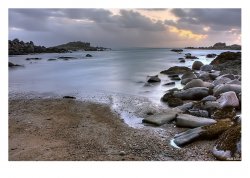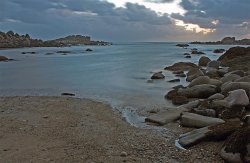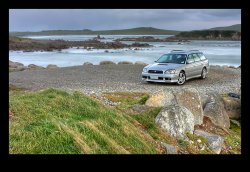Got a tip for us?
Let us know
Become a MacRumors Supporter for $50/year with no ads, ability to filter front page stories, and private forums.
HDR (High Dynamic Range) photography - post your HDR
- Thread starter valdore
- Start date
- Sort by reaction score
You are using an out of date browser. It may not display this or other websites correctly.
You should upgrade or use an alternative browser.
You should upgrade or use an alternative browser.
I feel like this wouldn't accomplish much...The point of HDR is that you have a huge range of light levels in your composition so you need multiple exposures to get all the detail in properly, right? With an available light portrait, you don't necessarily have a wide range of light levels.How about some available light portraits treated with HDR? Anyone?
Hi All,
First time posting to this forum. I have taken some HDR shots (mostly around Melbourne, AUS) and thought I would share. Let me know what you think!
Welcome!
I like the shot (a good example of when center-weighting the subject works), except for the excessive shadowing around the minor spires. Other than burning them, I wouldn't know how to fix it--perhaps Valdore, et. al. could be of more use.
Oh, and the clouds are blown out. But I love how the main tower and fountain seem to radiate light.
Yeah you are rightOh, and the clouds are blown out. But I love how the main tower and fountain seem to radiate light.
Two that I put together recently, a combo of HDR and then doing more edits in Aperture

I love how all of the cows are turned towards the camera. The HDR adds a surreal quality that meshes well with the bizarre fixation of the cows.
Nice, but as others have pointed out, the sky is blown out on the left. That shouldn't happen on an HDR (indeed, that is the point of HDR).
But otherwise, a nice composition.
My take is that a photograph is inherently a capture of a moment in time. Dodging and burning, contrast masking, saturation, etc, doesn't change this. It's still about a moment in time. When you blend multiple exposures (rather than different raw conversions from the same exposure) you're creating a digital composite. It's no longer a photograph; the photographs are inputs to the composite. Like newspapers used in a collage, it's no longer a newspaper. The act of compositing creates a new, inherently different, type of work.How is doing HDR work any different than taking a negative into an enlarger and dodging and burning it, using contrast filters, toning them, etc? There is no way to take a digital picture into a darkroom and use traditional darkroom techniques on it. That's what the "digital darkroom" is for. I consider any photo editing program to be a "digital darkroom" personally, whether it be Photoshop, Photomatix, or whatever. That's my personal take on this.
Painting is also a completely different type of work - even a courtroom sketch artist makes no claim to be producing a photograph. It's a sketch, and exactly what you see very likely never happened.
That said, I enjoy making digital composites and shoot to produce material for it (I shoot medium format digital on Mamiya 645) just like I typically like to present most of my photographs as non-composites. Their expressive power is different. They are inherently different, with different emotional response - and I see this as a good thing.
My take is that a photograph is inherently a capture of a moment in time. Dodging and burning, contrast masking, saturation, etc, doesn't change this. It's still about a moment in time. When you blend multiple exposures (rather than different raw conversions from the same exposure) you're creating a digital composite. It's no longer a photograph; the photographs are inputs to the composite. Like newspapers used in a collage, it's no longer a newspaper. The act of compositing creates a new, inherently different, type of work.
Painting is also a completely different type of work - even a courtroom sketch artist makes no claim to be producing a photograph. It's a sketch, and exactly what you see very likely never happened.
That said, I enjoy making digital composites and shoot to produce material for it (I shoot medium format digital on Mamiya 645) just like I typically like to present most of my photographs as non-composites. Their expressive power is different. They are inherently different, with different emotional response - and I see this as a good thing.
This is obviously a contentious issue - and a true definition of whether HDR is photography or something else is not yet upon us. However, I think it's worthwhile pointing out another type of photography that uses 'composites' and therefore shouldn't be (by your definition) called 'photographs'. That is, astrophotography - where to create a single image, photographers (or should I say, composite artists?) combine a number of exposures together to create their images.
As for my own opinion, I say that both HDR and astrophotography are types (or methods) of photography. However, a lot of what is being done with HDR is designed to deliberately make the image look more like a painting than a photograph. In which case I tend to think of these as 'digital artworks'.
The reason I'm okay with HDR being considered photography is because I don't adhere to the definition of photography being 'a moment in time' (there are too many multiple exposure photos to list, but here's a classic), but more of a reference to the media used (I've been an applied media art student for the last year - most definitions come down to the media used or what it is going to be used for). Also, when I think about it, some of my HDR shots have been made up of three images, totalling a period of maybe 10-15 seconds in time. This is, in many respects, more of a 'moment in time' than say, a 30 second single exposure.
In film photography, there are different types of film that each have different sized dynamic ranges. Different brands also, have different dynamic ranges. To me, HDR is essentially creating a 'film' which has a very very large dynamic range.
Here's a couple of images - the one on the left is HDR, the one on the right is the original exposure from the camera - tweaked with shadows/highlights, etc in Photoshop.
Attachments
My take is that a photograph is inherently a capture of a moment in time. Dodging and burning, contrast masking, saturation, etc, doesn't change this. It's still about a moment in time. When you blend multiple exposures (rather than different raw conversions from the same exposure) you're creating a digital composite. It's no longer a photograph; the photographs are inputs to the composite. Like newspapers used in a collage, it's no longer a newspaper. The act of compositing creates a new, inherently different, type of work.
If I shoot a three-shot HDR at f/8.0, 1/60s, 1/15s, and 1/250s (0, -2, +2 EV), that shot consists of less than 1/10 of a second of actual exposure time. How is that less of a "moment in time" than a 30 second exposure, which is just integrating light from the entire exposure?
HDR is just another tool; yes, it produces images that are not precisely consistent with what is in front of the camera (though not as much as we might think, given the DR of the human eye vs. a DSLR), but one could say that a neutral gradient filter alters the scene in smiliar ways, and no one says that shooting with an ND grad produces an "inherently different type of work".
Ansel Adams would have used HDR; no doubt about it.
Ansel Adams would have used HDR; no doubt about it.
He was certainly concerned with getting the full tonal range out of every exposure. His prints had a depth that digital fails to match: rich, deep blacks, detailed mid-tones, subtle highlights. To see an exhibition of prints by Adams (or many other photographers, going back pre-1900) is to realise the lustrous quality that was available from large-format cameras and lenses.
Yes, if he were alive today, he'd no doubt investigate the potential of HDR. But I feel sure he would tackle it in a careful, methodical way. The results would be amazing, I'm equally sure... but he wouldn't go in for eye-popping effects. He was too good a photographer for that...
If I shoot a three-shot HDR at f/8.0, 1/60s, 1/15s, and 1/250s (0, -2, +2 EV), that shot consists of less than 1/10 of a second of actual exposure time. How is that less of a "moment in time" than a 30 second exposure, which is just integrating light from the entire exposure?
Haha you obviously didn't read my post...
some of my HDR shots have been made up of three images, totalling a period of maybe 10-15 seconds in time. This is, in many respects, more of a 'moment in time' than say, a 30 second single exposure.
dabbled a bit in some HDR lately, using Photomatix. All my shots are AEB +/- 2ev with my XSi. Some of the later ones came out better imo.
let me know what you guys think
http://gallery.me.com/simonsb/100149
let me know what you guys think
http://gallery.me.com/simonsb/100149
dabbled a bit in some HDR lately, using Photomatix. All my shots are AEB +/- 2ev with my XSi. Some of the later ones came out better imo.
let me know what you guys think
http://gallery.me.com/simonsb/100149
Mansion HDR shows the most potential out of your shots here. It's a decent composition, although you need to pay more attention to things like the tilting horizon.
The others aren't so great, compositionally. Technically there are lots of alignment issues too. Practise will help in that department. As for composition, you have to treat HDR as you would for normal photography or painting - it still has to look good - think in thirds, try to lead the eye, etc.
Here's one of my li'l car.
Attachments
Mansion HDR shows the most potential out of your shots here. It's a decent composition, although you need to pay more attention to things like the tilting horizon.
The others aren't so great, compositionally. Technically there are lots of alignment issues too. Practise will help in that department. As for composition, you have to treat HDR as you would for normal photography or painting - it still has to look good - think in thirds, try to lead the eye, etc.
Here's one of my li'l car.
Very nice!! beautiful scenery!
Register on MacRumors! This sidebar will go away, and you'll see fewer ads.
















